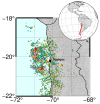Tsallis Entropy and Mutability to Characterize Seismic Sequences: The Case of 2007-2014 Northern Chile Earthquakes
- PMID: 37895538
- PMCID: PMC10606754
- DOI: 10.3390/e25101417
Tsallis Entropy and Mutability to Characterize Seismic Sequences: The Case of 2007-2014 Northern Chile Earthquakes
Abstract
Seismic data have improved in quality and quantity over the past few decades, enabling better statistical analysis. Statistical physics has proposed new ways to deal with these data to focus the attention on specific matters. The present paper combines these two progressions to find indicators that can help in the definition of areas where seismic risk is developing. Our data comes from the IPOC catalog for 2007 to 2014. It covers the intense seismic activity near Iquique in Northern Chile during March/April 2014. Centered in these hypocenters we concentrate on the rectangle Lat-22-18 and Lon-68-72 and deepness between 5 and 70 km, where the major earthquakes originate. The analysis was performed using two complementary techniques: Tsallis entropy and mutability (dynamical entropy). Two possible forecasting indicators emerge: (1) Tsallis entropy (mutability) increases (decreases) broadly about two years before the main MW8.1 earthquake. (2) Tsallis entropy (mutability) sharply decreases (increases) a few weeks before the MW8.1 earthquake. The first one is about energy accumulation, and the second one is because of energy relaxation in the parallelepiped of interest. We discuss the implications of these behaviors and project them for possible future studies.
Keywords: Tsallis entropy; information theory; subduction seismicity.
Conflict of interest statement
The authors declare no conflict of interest.
Figures








References
-
- Oumezzine M., Peña O., Kallel S., Zemni S. Critical phenomena and estimation of the spontaneous magnetization through magnetic entropy change in La0.67Ba0.33Mn0.98Ti0.02O3. Solid State Sci. 2011;13:1829–1834. doi: 10.1016/j.solidstatesciences.2011.07.019. - DOI
Grants and funding
LinkOut - more resources
Full Text Sources
Research Materials
Miscellaneous

